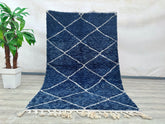Berber carpets: Recognizing the authentic from the fake
Berber Rugs: A Guide to Authentic Moroccan Craftsmanship
No matter its millennial history, Berber rugs have never faded from memory. On the contrary, these Moroccan rugs are at the center of contemporary decor. If your goal is to make your home unique, a Berber rug is a must-have.
However, the rising demand has also led to a surge of inauthentic reproductions. Many sellers take advantage of customers’ unfamiliarity, passing off machine-made or synthetic rugs as the real deal. Here’s how to identify genuine Berber carpets and support the artisans behind them.
1. Entirely Made of Wool
Real Berber rugs are crafted from 100% sheep's wool, a hallmark of authenticity and tradition. True Berber artisans use high-quality wool or cotton, while synthetic materials or entirely cotton carpets signal imitations. Authentic rugs showcase natural cream, beige, and ivory tones, highlighting the organic colors of wool.
Opting for sheep’s wool Berber rugs also makes you an environmentally conscious consumer. Wool can be harvested without harming sheep, allowing them to live comfortably and produce more wool over time. Choosing wool means investing in both quality and sustainability.
2. Unique Designs
Each Berber rug is a one-of-a-kind masterpiece, woven by hand in a process that cannot be exactly replicated. This uniqueness not only sets Berber carpets apart from other global designs but also ensures no two rugs are alike. The intricate hand-knotting creates distinctive patterns and textures, making each rug a personal piece of Moroccan culture.
3. Rare and Hard to Replicate
If you encounter a “Berber rug” with identical versions, it’s likely mass-produced. Authentic rugs are individually crafted, meaning replication is rare unless by special order. Machine-made rugs, on the other hand, often appear perfect and standardized. Genuine rugs have subtle imperfections, which add to their character and authenticity.
You can spot the difference by checking the back of the rug—machine-made carpets usually lack the slight irregularities found in handwoven pieces.
4. Value for Money
The time and effort involved in crafting an authentic Berber rug mean these pieces come at a higher cost. Each rug can take several weeks to complete, reflecting both quality and the weaver’s dedication. By choosing genuine carpets, you’re not only getting a piece that will last for decades but also supporting the livelihoods of skilled women artisans, who often depend on this income to support their families.
5. Fringe on One Side
Traditionally, authentic Berber rugs have a fringe on only one side, serving as the end of the weave. A single-sided fringe is often accompanied by a thin line of colored threads inlaid into the fabric, creating a subtle yet distinctive boundary. Modern designs may feature fringe on both ends, but single-sided fringe is the mark of a traditional, authentic piece.
Why Berber Rugs Add Value to Your Home
With a rich history and unique aesthetic, Berber rugs go beyond simple decor—they embody cultural craftsmanship and add a distinctive touch to any space. By choosing genuine, handmade Berber carpets, you bring a piece of Morocco’s tradition and soul into your home.
Featured Products
169 x 251 cm = 5.5 x 8.2 ft moroccan wool rug, moroccan style rug, bohemian rug, handmade rug, outdoor patio, beniourain Rug, decor rug, Handmade Gift
- $599.00
$1,830.00- $599.00
- (-67%)
- Unit price
- / per
155 x 247 cm = 5.1 x 8.1 ft Diamonds Blue Soft Dots Berber Runner Rug - Handmade Moroccan Wool, Minimalist Design, Vintage Style, Perfect for Weddings & Bohemian Decor
- $599.00
$1,830.00- $599.00
- (-67%)
- Unit price
- / per
- Beni Ourain rug
- Berber rug
- Berber tribes
- bohemian rug moroccan rug
- Custom Beni Ourain Rug
- Hand-woven rugs
- Handmade rug imperfections
- modern moroccan rug
- Moroccan Berber rug
- Moroccan heritage
- Moroccan rug buying guide
- morrocan rug
- Neutral hue rugs
- Plush texture rugs
- Rug interior alignment
- Timeless rug designs
- Traditional rug design
- warm rug
- white beni ourain










